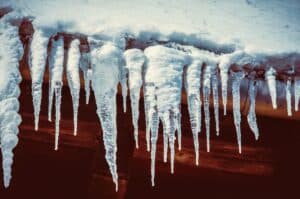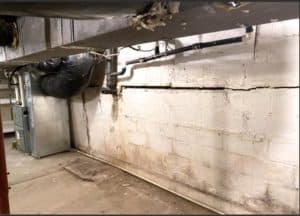
Originally posted 4/8/19, updated 12/15/21
Snow and ice may be collecting on your roof, but that doesn’t limit the scope of the damage it can do. The weight of that frozen precipitation can do more than press down on your roof and seep into any roof cracks or openings. Melting snow also can create problems with a home’s foundation and basement walls.
Acculevel is a family-owned and operated company that specializes in foundation repair and waterproofing. Based out of Rossville, Indiana, we’re very familiar with winter extremes. Midwestern winters come with wide-ranging temperatures from below zero to above 40, often in the same week. This poses some unique challenges for homeowners dealing with snowmelt and ice dams.
Since our start in 1996, we’ve helped more than 35,000 homeowners restore strength, stability, and health to their homes. We offer whole-home solutions; options that are designed to treat both the symptoms and the source of your home’s issue. In this article, we’re going to explain how winter weather affects your home, and steps you can take to prevent major damage.
Snow load is the weight of the accumulated snow and ice on the roof of your home. Houses are designed and built to withstand the average amount in your specific area or region.
Above average snowfall can be a threat to your roof. Back in 2010, football fans were reminded of this fact when a major winter storm caused the Metrodome to collapse. It’s unlikely your home will react in such a dramatic fashion; you should notice cold drafts and a leaky roof long before anything so extreme happens.
But snow load can be a structural problem, if the winter is especially severe. A common issue in the Midwest is the fluctuating temperatures. Warmer days can melt some of the snow, only to refreeze after nightfall. This buildup of ice is part of what becomes an ice dam.

An ice dam is forming over the guttering on this house.
Ice dams are formed when snow melts on the roof, then starts to refreeze along the edge. As it builds up, it creates a dam that blocks melted snow from draining into the guttering. The greatest contributor to ice dams is a lack of insulation in the attic.
This is because heated air inside the house warms up the shingles, but does not reach all the way to the edge of your roof. The shingles around the outside perimeter of the roof stay cold. It’s this contrast in temperatures that creates a dam.
Snow that melts in the sun doesn't cause an ice dam, but it will make an existing dam worse.
Ice Dams and snow loads have something in common: they melt. And when these chilly problems melt, they create what is often called “snowmelt.”
What’s the difference between snowmelt and run-off? The season. Water run-off can happen at any time, while snowmelt is caused when snow and ice melt.
Snowmelt creates a large amount of water that drains off your roof in a short amount of time. Ideally, this water would go into your gutters so it would be carried away from your house. But if you have an ice dam formed over the gutter, the snowmelt is going to slide off the roof instead.
This involuntary rerouting makes the snowmelt drip directly next to your home’s foundation. And this is how it causes problems for you and your foundation.
You don’t ever want water from the roof draining straight down against the house. That’s exactly why guttering exists- to direct water away from your home. Water running down the side of the house is going to end up pooling around the foundation.
Snowmelt makes this especially difficult, because the ground is usually still somewhat frozen. Frozen earth doesn’t absorb water, so water next to your house doesn’t have anywhere to go- except into your house. So melting ice dams and snowmelt can cause water intrusion in your basement or crawl space.
But they can also cause other types of damage. Your foundation is built out of porous material that will let water inside it. (Concrete, brick, mortar, and cinder block are all porous.) Water inside your foundation will create tiny gaps that gradually widen into cracks. Even worse, the temperature may drop while your foundation is wet, which causes the water inside to freeze and expand. This also creates cracks, but at a faster rate.
Cracked foundation walls can become bowing walls. Bowing walls compromise your home’s structural integrity, and if they bow badly enough? They may even fall down. This is why it is so urgent for you fix a bowing foundation wall.

This photo was taken by an Acculevel project advisor during a free in-home assessment. The basement wall is cracked and beginning to bow inward.
If you don’t currently have any problems (cracks, water intrusion, bowing walls) with your foundation, take preventative measures! In this article about drainage problems, we review four steps you can take to avoid water leaks.
However, if you are already seeing signs of damage- especially cracks in your foundation- you should have these evaluated and repaired as soon as possible. Fixing a small problem is always less expensive than a large one, and home repairs are no exception.
Check out our comprehensive guide to foundation problems and repairs. This homeowner’s guide is available (at no charge) to any homeowner who wants to know more about signs, symptoms, repair methods and costs.
If you live in our service area (click here for an interactive map), please call Acculevel at 866-669-3349. We will schedule an appointment for you with one of our friendly and experienced project advisors.
Would you prefer to communicate by email or text?
Let us know that when you complete our online form!
When your project advisor comes to your home, they will discuss your concerns and what signs or symptoms you’ve seen. They will then thoroughly assess your home, diagnose the issues, and determine what the repair options are. As a team, you and your advisor will determine what the best course of action will be, to protect and preserve your home for the future.
If you don’t live in our service area- or if you want to know more about us- please read our guide to questions you should ask a contractor. The article explains what questions we recommend you ask, why you should ask them, and what answers should be potential concerns. It also gives our answers to all of these questions, and comes with a free downloadable (blank) version you can use when meeting with other companies.
We know most of the companies in this industry are hardworking and reputable businesses, but we don’t want anyone to be cheated by a con artist impersonating a contractor. Please always verify that the company you hire is properly insured and accredited by the Better Business Bureau.
[DISPLAY_ULTIMATE_SOCIAL_ICONS]